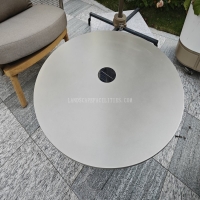Welcome to the website for landscape facilities products and knowledge.
How does the design of a landscape bar counter influence its ability to resist damage from high-traffic use?
The landscape bar counter serves as the bustling epicenter of any vibrant hospitality venue, from upscale cocktail lounges to busy restaurant bars. Its ability to resist damage under constant, high-traffic use is not a matter of chance but a direct result of intentional, multifaceted design. This resilience is engineered through a critical combination of material science, structural integrity, and practical detailing.
Firstly, the selection of materials is paramount. Designers prioritize surfaces with inherent hardness and non-porosity. Engineered quartz, for instance, offers exceptional scratch resistance and is impervious to stains from spilled wines, citrus juices, and cleaning chemicals. Solid surfaces, renowned for their repairability, allow for scratches and minor burns to be sanded away seamlessly. For a more natural aesthetic, hardwoods like sealed oak or walnut are treated with industrial-grade polyurethane finishes that create a protective, durable shield against moisture and impact. The choice directly dictates the counter's longevity and defines its maintenance regimen.
Beyond the surface, the underlying structural design is crucial. A robust substrate, typically constructed from plywood or metal framing, provides essential stability, preventing sagging or flexing that can lead to surface material cracking over time. The integration of sturdy support brackets, well-anchored to the floor or wall, mitigates the lateral forces and vibrations caused by leaning patrons and constant activity. The overhang design is also calculated; while necessary for guest comfort, its length is optimized and supported with decorative corbels or columns to prevent catastrophic failure from downward pressure.
Furthermore, functional design elements directly contribute to damage resistance. Rounded edges and corners, or bullnose profiles, are not merely an aesthetic choice. They are significantly less prone to chipping than sharp, 90-degree angles when accidentally struck by service trays, bags, or furniture. The integration of dedicated drainage channels within the countertop can swiftly divert spills, preventing liquid from seeping into vulnerable seams or edges where it can cause delamination or water damage to the substructure.
Finally, the relationship between design and daily upkeep is inseparable. A well-designed landscape bar counter incorporates elements that simplify cleaning. Continuous surfaces with minimal seams prevent dirt and moisture accumulation. The selected materials must withstand the frequent use of strong disinfectants without degrading, fading, or losing their luster. Thus, the design proactively reduces wear from maintenance itself, ensuring the counter remains aesthetically pleasing and structurally sound despite the relentless demands of a commercial environment. In conclusion, a damage-resistant landscape bar counter is a holistic system where every design decision, from the molecular structure of its surface to the strength of its supports, works in concert to ensure durability and performance under pressure.
Related search:

Recommendation
Outdoor stainless steel table with solar-powered ambient lighting feature - excellent design.